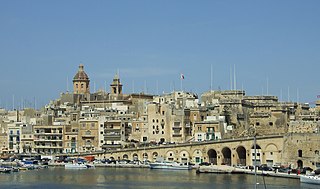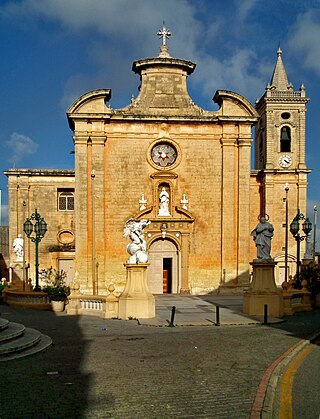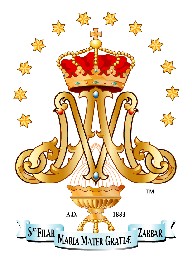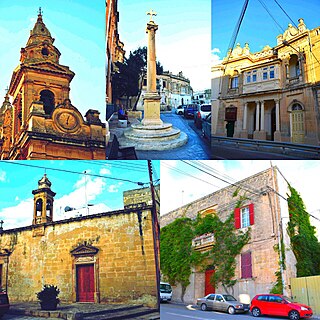
Valletta is the capital city of Malta and one of its 68 council areas. Located between the Grand Harbour to the east and Marsamxett Harbour to the west, its population as of 2014 was 6,444. As Malta’s capital city, it is a commercial centre for shopping, bars, dining, and café life. It is also the southernmost capital of Europe, and at just 0.61 square kilometres (0.24 sq mi), it is the European Union's smallest capital city.

Floriana, also known by its title Borgo Vilhena, is a fortified town in the South Eastern Region area of Malta, just outside the capital city Valletta. It has a population of 2,205 as of March 2014. Floriana is the birthplace of many famous Maltese, amongst which the composer of the national anthem, 'L-Innu Malti', Robert Samut; former Bishop of Malta Dun Mauro Caruana, the poets Oliver Friggieri and Maria Grech Ganado, the writer and politician Herbert Ganado and Swedish Idol winner Kevin Borg.

Birgu, also known by its title Città Vittoriosa, is an old fortified city on the south side of the Grand Harbour in the South Eastern Region of Malta. The city occupies a promontory of land with Fort Saint Angelo at its head and the city of Cospicua at its base. Birgu is ideally situated for safe anchorage, and over time it has developed a very long history with maritime, mercantile and military activities.

Balzan is a municipality in the Central Region of Malta, one of the so-called three villages, together with Attard and Lija. The village originally consisted of a group of small dwellings and farms but eventually grew, becoming a parish in the 17th century. As of 2021, the town registered a population of 4,774 inhabitants.

Victoria, also known among the native Maltese as Rabat or by its title Città Victoria, is an administrative unit of Malta, and the main town on Gozo. Victoria has a total population of 6,901, and by population, is the largest locality in Gozo.

Senglea, also known by its title Città Invicta, is a fortified city in the South Eastern Region of Malta. It is one of the Three Cities in the Grand Harbour area, the other two being Cospicua and Vittoriosa, and has a population of approximately 2,720 people. The city's title Città Invicta was given because it managed to resist the Ottoman invasion at the Great Siege of Malta in 1565. The name Senglea comes from the Grand Master who built it Claude de la Sengle and gave the city a part of his name. While Senglea is the 52nd most populated locality on the island, due to its incredibly small land area, it is the 2nd most densely populated locality after Sliema.

Sliema is a town located on the northeast coast of Malta in the Northern Harbour District. It is a major residential and commercial area and a centre for shopping, bars, dining, and café life. It is also the most densely populated town on the island.

Paola is a town in the South Eastern Region of Malta, with 8,706 inhabitants as of 2019. The town is a commercial centre in the Southern Harbour area of Malta, about 5 km from the capital Valletta, contiguous to Tarxien and Fgura, with which it forms a single urban area. Paola is named after Grand Master Antoine de Paule, who laid the foundation stone in 1626.

Hamrun is a town in the Central Region of Malta, with a population of 9,244 as of March 2014.

Żebbuġ, also known by its title Città Rohan, is a city in the Southern Region of Malta. It is one of the oldest towns in the country, and its population is 11,074 as of June 2021.

The Società Filarmonica Maria Mater Gratiæ is a band club in Żabbar, Malta.

Valletta F.C. is a professional football club based in Valletta, the capital city of Malta, and competes in the Maltese Premier League, the top flight of Maltese football. The club was founded in 1943 after a merge of Valletta Prestons, Valletta St. Paul's and Valletta United, the latter being a two-time league winner before the Second World War.

Elizabeth II was the only queen of the State of Malta, which existed from 1964 to 1974. The State of Malta was an independent sovereign state and a constitutional monarchy, which shared a monarch with other Commonwealth realms, including the United Kingdom. Elizabeth's constitutional roles in Malta were mostly delegated to a governor-general.

The Grandmaster's Palace, officially known as The Palace, is a palace in Valletta, Malta. It was built between the 16th and 18th centuries as the palace of the Grand Master of the Order of St. John, who ruled Malta from 1530 to 1798, and was also known as the Magisterial Palace. When the knights were expelled by Napoleonic France, it became the National Palace. During the period of British rule beginning in 1800, it was the Governor's Palace.

The George Cross was awarded to the island of Malta by King George VI during the Siege of Malta undertaken by Italy and Germany in the early part of World War II. In a letter to the island's Governor, Lieutenant-General Sir William Dobbie, King George wrote, "so as to bear witness to the heroism and devotion of its people". The island was a British colony from 1813 to 1964. The George Cross was incorporated into the flag of Malta beginning in 1943 and remains on the current design of the flag.

Luqa is a town located in the Southern Region of Malta, 4.3 km away from the capital Valletta. With a population of 5,945 as of March 2014, it is a small but densely populated settlement which is typical of Malta's older towns and villages. Luqa is centered around a main square which contains a church dedicated to St. Andrew. The patron saint's traditional feast is celebrated on the first Sunday of July, with the liturgical feast being celebrated on 30 November. The Malta International Airport is located in Luqa.

Villa Guardamangia, formerly known as Casa Medina and sometimes referred to as Casa Guardamangia, is a 16,791 square feet (1,559.9 m2) townhouse in Gwardamanġa, Pietà, Malta, which served as the residence of Princess Elizabeth, Duchess of Edinburgh, and Prince Philip, Duke of Edinburgh, between 1949 and 1951, while Philip was stationed in Malta as a naval officer.

AntonioNani was a Maltese composer and a member of a prominent family of Maltese musicians and composers. He composed both sacred music and operas.

The de Piro family is a Maltese noble family, of Italian origins, which settled in Malta with the Order of St John in 1530.

Giuseppe Monterosso was an Italian flautist, composer, conductor and music teacher.



















